Dr. Paul Wilbur Receives Lifetime Achievement Medal
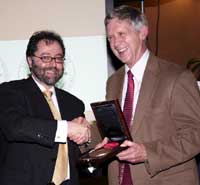 |
|
Dr. Paul Wilbur receives the Medal of Outstanding Achievement in Electric Propulsion from the Electric Propulsion Society
|
When ion propulsion propels the first spacecraft to Jupiter or delivers supplies for people going to Mars, CSU Professor Paul Wilbur and students will have a reason to celebrate. Instrumental in proving that this technology was the best means to propel spacecraft to distant planets, Wilbur, his space program and the vision he has passed on to innumerable students will have made it possible. Through four decades of research and the countless lives he has touched along the way, Dr. Paul Wilbur has impacted the field of ion propulsion and space exploration as a phenomenal researcher and world-class educator. Wilbur was recently recognized for his lifetime achievements with one of the most prestigious awards in this field, the "Medal of Outstanding Achievement in Electric Propulsion."
One of only a few recipients worldwide, Dr. Wilbur was honored by the Electric Propulsion Society at the International Electric Propulsion Conference Gala Dinner held this September in Florence, Italy for his seminal work, his many classic contributions to ion propulsion, and his invaluable role in electric propulsion education. Edgar Choueiri, president of the Electric Rocket Propulsion Society, presented the award to Dr. Wilbur and two other individuals this fall. Only eight researchers have received this honor since its inception in 2005. Dr. Robert Jahn, professor of aerospace and mechanical sciences at Princeton University and Wilbur's graduate adviser, received one of the original five awards. Wilbur is the first student of Jahn's to also be honored with this lifetime achievement medal.
Ion propulsion, a fuel efficient and low thrust form of spacecraft propulsion, utilizes accelerated ions produced from xenon gas to increase the speed of a spacecraft. After being accelerated through sets of hole pairs in two closely spaced metal plates, xenon ions escape into space at very high exhaust velocities thereby imposing a force on the spacecraft, and thus propelling it toward its destination.
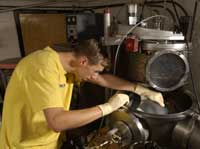 |
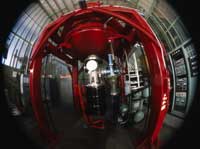 |
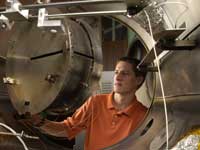 |
Dr. Wilbur began his career in ion propulsion during a time of revolutionary discovery and innovation in space exploration. Inspired by Jahn, Wilbur earned a Ph.D. from Princeton University before joining the faculty at Colorado State University in 1968. A fantastic mentor, Jahn instilled in Wilbur a vision, based on work of Goddard and other visionaries from a century before, of expanding space flight to the outer planets - only a dream of NASA and international space agencies at the time. Although one of only a handful of scientists involved in electric propulsion in the early days, Wilbur has taken this vision and turned it into practical application through the educational and research enterprise he created at CSU.
"In our lab at CSU, we are doing the basic research to try to understand how electric propulsion works. Anyone can build a system, but to make them better you need to understand the processes that are going on and be able to model them," said Wilbur. "Rather than physically building system after system to test, we are using computer models to determine how to improve them. I think that has been our contribution — helping people make better thrusters and ultimately helping enable the acceptance of this technology. People are beginning to understand it isn't magic."
Today, deep space flight is becoming a reality, thanks to the diligence of researchers like Wilbur, and the high-caliber students he is producing. Deep Space 1, the first use of an ion thruster for primary spacecraft propulsion, was Wilbur and ion propulsion's first great success, accumulating more than 16,000 hours of thrusting. The longest firing time of any thruster in space, the Solar Electric Propulsion Technology Application Readiness (NSTAR) ion thruster propelled a satellite to the comet Borelly and past the asteroid Braille.
"Soon after I became involved in ion propulsion, NASA had the first launch into orbit of an ion thruster. We contributed to the physical understating of the processes that were occurring in these early ion propulsion devices," said Wilbur. "It is because of the students involved in our program that we have done so well."
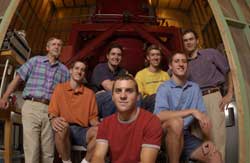 |
|
Dr. Paul Wilbur with Assistant Professor Dr. John Williams and students
|
Click here to read more on Dr. Wilbur and his research.
For more information on ion propulsion please visit http://www.engr.colostate.edu/ionstand/index.php